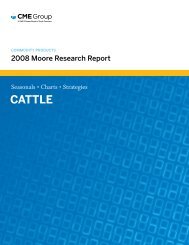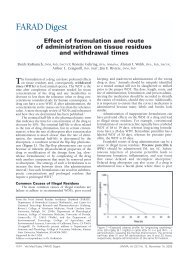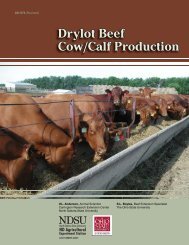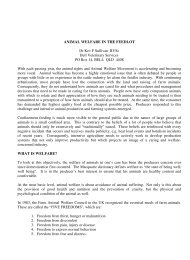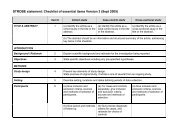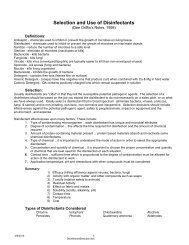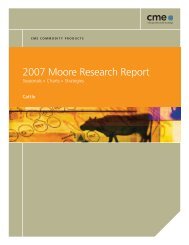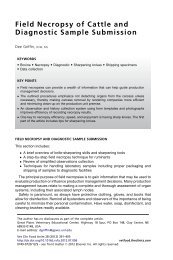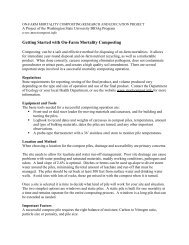Effect of management strategies on reducing heat stress of feedlot ...
Effect of management strategies on reducing heat stress of feedlot ...
Effect of management strategies on reducing heat stress of feedlot ...
You also want an ePaper? Increase the reach of your titles
YUMPU automatically turns print PDFs into web optimized ePapers that Google loves.
3080<br />
Table 2. <str<strong>on</strong>g>Effect</str<strong>on</strong>g> <str<strong>on</strong>g>of</str<strong>on</strong>g> managed feeding regimen <strong>on</strong> feed and<br />
water intake <str<strong>on</strong>g>of</str<strong>on</strong>g> yearling steers in Exp. 1<br />
Treatments a<br />
Item ADLIB BKMGT LIMFD SEM<br />
Weight, kg<br />
Initial (d 0) 433 434 432 0.9<br />
Interim (d 23) 480 b<br />
482 b<br />
469 c<br />
2.6<br />
d 82<br />
DMI, kg/d<br />
582 583 585 3.6<br />
d 0 to 23 9.60 b<br />
9.59 b<br />
8.44 c<br />
0.13<br />
d 24 to 82 10.61b 10.98 bc<br />
11.41 c<br />
0.22<br />
d 0 to 82<br />
G:F<br />
9.78 9.97 10.01 0.16<br />
d 0 to 23 0.213 0.217 0.191 0.009<br />
d 24 to 82 0.164 bc<br />
0.157 b<br />
0.171 c<br />
0.004<br />
d 0 to 82<br />
Water intake, L/d<br />
0.187 0.183 0.185 0.003<br />
d 0 to 23 33.15 33.46 27.52 1.69<br />
d 24 to 82 41.06 e<br />
43.49 e<br />
35.03 d<br />
0.63<br />
d 0 to 82 39.35 de<br />
41.18 e<br />
32.58 d<br />
0.87<br />
Water intake, L/Mcal <str<strong>on</strong>g>of</str<strong>on</strong>g> ME intake<br />
d 0 to 23 1.13 1.15 1.03 0.05<br />
d 24 to 82 1.22de 1.31e 1.02d 0.03<br />
d 0 to 82 1.28 e<br />
1.36 e<br />
1.08 d<br />
0.02<br />
a<br />
ADLIB = cattle were allowed access to feed at all times; BKMGT =<br />
cattle were fed at 1600 with bunks slick at 0800 the following day;<br />
LIMFD = cattle were delivered 85% <str<strong>on</strong>g>of</str<strong>on</strong>g> their predicted DMI at 1600.<br />
The BKMGT and LIMFD regimens were utilized for the first 23 d <str<strong>on</strong>g>of</str<strong>on</strong>g><br />
experiment.<br />
b,c<br />
Means within a row that do not have comm<strong>on</strong> superscripts differ<br />
(P < 0.05).<br />
d,e<br />
Means within a row that do not have comm<strong>on</strong> superscripts tended<br />
to differ (0.05 < P < 0.10).<br />
lyzed for the effect <str<strong>on</strong>g>of</str<strong>on</strong>g> sprinkling within each main effect<br />
<str<strong>on</strong>g>of</str<strong>on</strong>g> feeding regimen.<br />
Results<br />
Envir<strong>on</strong>mental c<strong>on</strong>diti<strong>on</strong>s associated with the various<br />
periods <str<strong>on</strong>g>of</str<strong>on</strong>g> <strong>heat</strong> <strong>stress</strong> during these experiments are<br />
provided by Davis et al. (2003). Experiments 1 and 2<br />
were c<strong>on</strong>ducted simultaneously over an 82-d time period.<br />
Mean daily (± SD) temperature and THI for Exp.<br />
1 and 2 were 22.1 ± 3.5°C and 69.5 ± 5.5°C, respectively.<br />
In Exp. 3, mean daily (± SD) temperature and THI were<br />
22.8 ± 3.20°C and 70.5 ± 4.7°C, respectively, during the<br />
22- to 83-d period treatments were imposed.<br />
Experiment 1<br />
Body weight, feed intake, gain efficiency, and water<br />
intake for the different feeding regimens are shown in<br />
Table 2. During the managed feeding period, LIMFD<br />
steers had a lower (P < 0.05) BW gain and DMI. This<br />
decrease in DMI was c<strong>on</strong>sistent with the treatment<br />
design. Following the initiati<strong>on</strong> <str<strong>on</strong>g>of</str<strong>on</strong>g> ad libitum feeding<br />
(d 24 to 82), LIMFD steers exhibited a 7.0% (P < 0.05)<br />
compensatory increase in DMI when compared with<br />
the DMI <str<strong>on</strong>g>of</str<strong>on</strong>g> the ADLIB treatment group. However, the<br />
BKMGT treatment group exhibited <strong>on</strong>ly a 3.5% numerical<br />
compensatory intake resp<strong>on</strong>se when compared with<br />
Mader and Davis<br />
Figure 1. Mean bunk scores <str<strong>on</strong>g>of</str<strong>on</strong>g> cattle fed ad libitum at<br />
0800 <strong>on</strong> d 9 and 13 (therm<strong>on</strong>eutral = TNL), 11 and 12<br />
(first <strong>heat</strong> <strong>stress</strong> period = HS1), 14 and 15 (moderate <strong>heat</strong><br />
<strong>stress</strong> = MHS), and 21 and 22 (sec<strong>on</strong>d <strong>heat</strong> <strong>stress</strong> period =<br />
HS2) <str<strong>on</strong>g>of</str<strong>on</strong>g> Exp. 1. a Bunk scores were assigned based <strong>on</strong> a 0<br />
to 2 scale: 0 = 50% <str<strong>on</strong>g>of</str<strong>on</strong>g> feed<br />
delivered remaining. Envir<strong>on</strong>mental c<strong>on</strong>diti<strong>on</strong>s were<br />
based <strong>on</strong> the temperature-humidity index (THI) and classified<br />
as follows: TNL = mean THI < 70; moderate <strong>heat</strong><br />
<strong>stress</strong> (MHS) = mean THI between 70 to 74; <strong>heat</strong> <strong>stress</strong> =<br />
mean THI between 74.1 and 77. *Bunk scores within an<br />
observati<strong>on</strong> time differ (χ 2 P < 0.05).<br />
the ADLIB group. These increases in DMI found during<br />
the ad libitum feeding period for the LIMFD treatment<br />
groups were achieved with a relatively short (23 d)<br />
managed feeding period. As a result <str<strong>on</strong>g>of</str<strong>on</strong>g> the LIMFD<br />
group compensating for the weight gain not realized<br />
during the 23-d managed feeding phase, weight gain<br />
and efficiency <str<strong>on</strong>g>of</str<strong>on</strong>g> feed c<strong>on</strong>versi<strong>on</strong> were increased (P <<br />
0.05) during the 24- to 82-d feeding period for the<br />
LIMFD group, particularly when compared with the<br />
BKMGT group. Water intake was similar during the<br />
ad libitum period between ADLIB and BKMGT steers,<br />
but numerically (although not significantly, P > 0.10)<br />
lower in LIMFD steers. This decrease resulted in overall<br />
water intake <str<strong>on</strong>g>of</str<strong>on</strong>g> LIMFD steers tending to be 16 and<br />
22% (P < 0.10) lower than ADLIB and BKMGT steers,<br />
respectively. When expressing water intake as L/Mcal<br />
<str<strong>on</strong>g>of</str<strong>on</strong>g> ME intake, LIMFD steers tended to have lower water<br />
intake (P < 0.10) than ADLIB and BKMGT steers over<br />
the entire experiment.<br />
Bunk scores for ADLIB steers during the managed<br />
feeding phase in Exp. 1 across TNL (d 9 and 13), the<br />
first HS period (HS1: d 11 and 12), MHS (d 14 and<br />
15), and the sec<strong>on</strong>d HS period (HS2: d 21 and 22) are<br />
presented in Figure 1. Compared within an observati<strong>on</strong>




